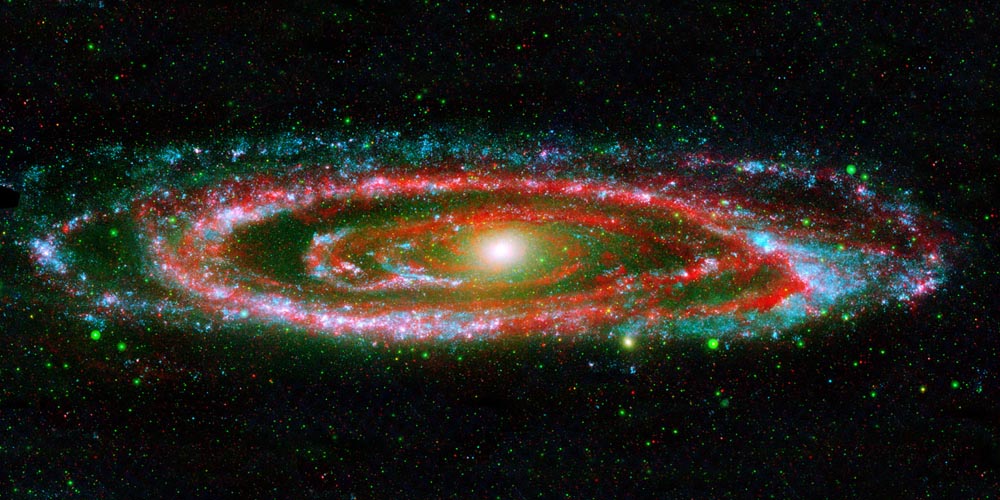
Spiral Galaxy
RA 0h 42m 44.9s Dec 41° 16' 20.8"
Andromeda
2,500,000 Light Years
2.6 x 0.8 degrees
North is 53.0° left of vertical
NASA/JPL-Caltech/K. Gordon (U of Arizona) & GALEX Science Team
October 03, 2006
Spitzer image: G0624 Wise: G1004 Galex: G1205 Hubble: G1502
ABOUT THIS IMAGE:
The many "personalities" of our great galactic neighbor, the Andromeda galaxy, are exposed in this new composite image from NASA's Galaxy Evolution Explorer and the Spitzer Space Telescope.
The wide, ultraviolet eyes of Galaxy Evolution Explorer reveal Andromeda's "fiery" nature -- hotter regions brimming with young and old stars. In contrast, Spitzer's super-sensitive infrared eyes show Andromeda's relatively "cool" side, which includes embryonic stars hidden in their dusty cocoons.
Galaxy Evolution Explorer detected young, hot, high-mass stars, which are represented in blue, while populations of relatively older stars are shown as green dots. The bright yellow spot at the galaxy's center depicts a particularly dense population of old stars.
Swaths of red in the galaxy's disk indicate areas where Spitzer found cool, dusty regions where stars are forming. These stars are still shrouded by the cosmic clouds of dust and gas that collapsed to form them.Together, Galaxy Evolution Explorer and Spitzer complete the picture of Andromeda's swirling spiral arms. Hints of pinkish purple depict regions where the galaxy's populations of hot, high-mass stars and cooler, dust-enshrouded stars co-exist.
Located 2.5 million light-years away, the Andromeda is our largest nearby galactic neighbor. The galaxy's entire disk spans about 260,000 light-years, which means that a light beam would take 260,000 years to travel from one end of the galaxy to the other. By comparison, our Milky Way galaxy's disk is about 100,000 light-years across.
This image is a false color composite comprised of data from Galaxy Evolution Explorer's far-ultraviolet detector (blue), near-ultraviolet detector (green), and Spitzer's multiband imaging photometer at 24 microns (red).